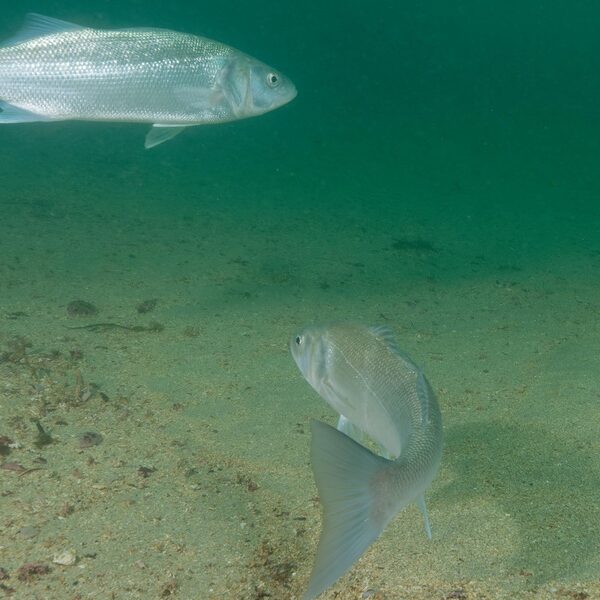The United Arab Emirates is a surprising mosaic of habitats — sweeping desert, rugged mountains, coastal mangroves and offshore islands — that support a varied mammal fauna. Whether you’re curious about small desert specialists or shy mountain dwellers, the country’s mammals tell the story of adaptation to a hot, arid landscape and scattered green pockets.
There are 34 Mammals of the United Arab Emirates, ranging from the African/Arabian Wildcat to the Trident Leaf-nosed Bat. For each species you’ll find below the Scientific name, Typical adult weight (kg), UAE distribution to help you compare size and where to look, and practical notes on occurrence you’ll find below.
Which of these mammals am I most likely to spot in the UAE?
Look for animals in their best habitats: coastal and mangrove areas for small cetaceans and shore-associated species, wadis and cliffs in the Hajar Mountains for the Arabian tahr and mountain foxes, and open desert at dawn or dusk for foxes, gazelles and the African/Arabian wildcat; bats like the Trident Leaf-nosed Bat are mostly nocturnal and often seen near water or roost sites with a torch and patience.
Are any of the listed mammals protected or at conservation risk?
Yes — several species have restricted ranges or declining populations and are protected under local and international listings; the status varies from least concern to vulnerable or endangered, so check the IUCN Red List and UAE environmental authorities for up-to-date protection status and local regulations before planning any wildlife visits.
Mammals of the United Arab Emirates
| Common name | Scientific name | Typical adult weight (kg) | UAE distribution |
|---|---|---|---|
| Arabian Oryx | Oryx leucoryx | 80 | Central deserts, Abu Dhabi reserves |
| Arabian Sand Gazelle | Gazella marica | 25 | Coastal plains, islands, northern emirates |
| Dromedary (Feral/ Domestic) | Camelus dromedarius | 450 | Nationwide (domestic and feral) |
| Rüppell’s Fox | Vulpes rueppelli | 3 | Deserts and dunes, nationwide |
| Blanford’s Fox | Vulpes cana | 2 | Hajar Mountains (Sharjah, Ras Al Khaimah) |
| Golden Jackal | Canis aureus | 9 | Widespread coastal plains and interior |
| Arabian Wolf | Canis lupus | 20 | Rare; desert and remote areas |
| Striped Hyena | Hyaena hyaena | 40 | Rare; desert and interior regions |
| Caracal | Caracal caracal | 17 | Scattered in deserts and mountains |
| Sand Cat | Felis margarita | 2.5 | Sandy deserts and dunes |
| African/Arabian Wildcat | Felis lybica | 4.5 | Desert edges, agricultural fringes |
| Jungle Cat | Felis chaus | 8 | Wetlands, lagoons and irrigated areas |
| Cape Hare | Lepus capensis | 3 | Deserts, plains and dunes |
| Desert Hedgehog | Paraechinus aethiopicus | 0.6 | Dunes, scrub and rocky areas |
| Long-eared Hedgehog | Hemiechinus auritus | 0.2 | Rocky areas and Hajar foothills |
| Small Indian Mongoose | Urva auropunctata | 0.8 | Coastal areas, oases; introduced |
| House Mouse | Mus musculus | 0.02 | Widespread urban and rural areas |
| Black Rat | Rattus rattus | 0.18 | Ports, towns and older buildings |
| Brown Rat | Rattus norvegicus | 0.25 | Urban areas, sewers and farms |
| Asian House Shrew | Suncus murinus | 0.06 | Urban, ports and farms (introduced) |
| Sundevall’s Jird | Meriones crassus | 0.08 | Sandy deserts and dunes |
| Balochistan Gerbil | Gerbillus nanus | 0.02 | Desert plains and sandy habitats |
| Kuhl’s Pipistrelle | Pipistrellus kuhlii | 0.01 | Widespread urban, agricultural and desert areas |
| Egyptian Fruit Bat | Rousettus aegyptiacus | 0.15 | Coastal towns and caves; roosts in buildings |
| Greater Mouse-tailed Bat | Rhinopoma microphyllum | 0.03 | Desert caves and old structures |
| Lesser Mouse-tailed Bat | Rhinopoma hardwickii | 0.03 | Desert roosts and caves |
| Egyptian Tomb Bat | Taphozous perforatus | 0.06 | Roosts in caves, ruins and buildings |
| Trident Leaf-nosed Bat | Asellia tridens | 0.01 | Caves and rocky shelters in deserts |
| Dugong | Dugong dugon | 250 | Shallow coastal waters, Abu Dhabi and east coast |
| Common Bottlenose Dolphin | Tursiops truncatus | 200 | Coastal and offshore waters nationwide |
| Indo-Pacific Humpback Dolphin | Sousa plumbea | 120 | Coastal waters, especially Gulf of Oman coast |
| Spinner Dolphin | Stenella longirostris | 60 | Offshore waters, occasional sightings |
| Striped Dolphin | Stenella coeruleoalba | 80 | Offshore, vagrant to UAE waters |
| Risso’s Dolphin | Grampus griseus | 300 | Offshore, irregular occurrences |
Images and Descriptions

Arabian Oryx
Large white antelope with straight ringed horns and dark facial markings. Reintroduced and native; best seen in protected reserves. Distinctive silhouette and herd behavior make ID easy. Conservation success story after near-extirpation; shy and predominantly diurnal.

Arabian Sand Gazelle
Slender, pale gazelle with curved horns in males and graceful build. Native and locally threatened; often found in small herds near dunes and salt flats. Look for reddish flank markings and high, bounding gait at dawn or dusk.

Dromedary (Feral/ Domestic)
Single-humped camel widely domesticated; feral individuals roam desert outskirts. Large, slow-moving with long legs and distinctive hump. Introduced/domesticated but also free-ranging; culturally and economically important across UAE.
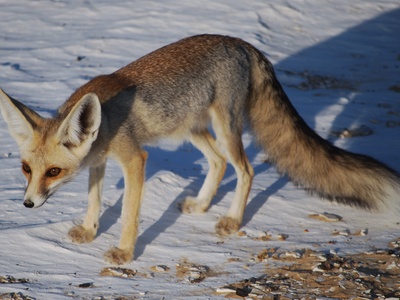
Rüppell’s Fox
Small desert fox with large ears, pale grey coat and bushy tail. Native and nocturnal; ears and size distinguish it from red fox. Common in sandy habitats, often seen on night surveys or roadkills at dawn.
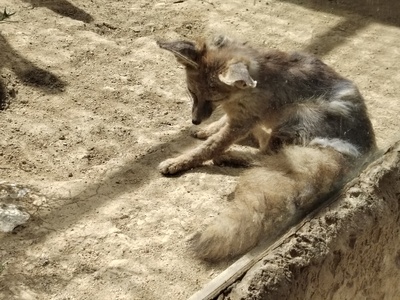
Blanford’s Fox
Small mountain fox with large ears and bushy tail, adapted to rocky gorges. Native and mainly nocturnal; more arboreal-looking than desert foxes. Rare but reported in Hajar foothills and wadis.

Golden Jackal
Medium-sized canid with golden-brown coat and bushy tail. Native and adaptable; frequents agricultural areas, scrub and urban fringes. Vocal at night; smaller and more golden than wolves, often scavenges.
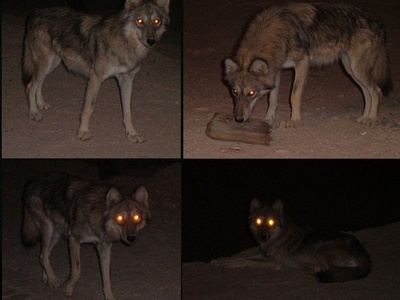
Arabian Wolf
Smaller subspecies of gray wolf, slender with long legs and pale coat. Native but rare in UAE; occasional sightings and records from remote deserts. Shy, often nocturnal, and distinguished from jackals by size and pack behavior.
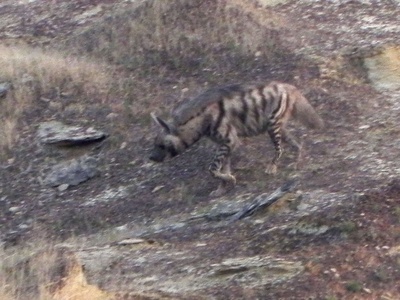
Striped Hyena
Large, dog-like hyena with striped flanks, mane and sloping back. Native and mostly nocturnal scavenger; rare but present in remote desert areas. Identified by characterful laugh-like calls and bone-crushing feeding behavior.
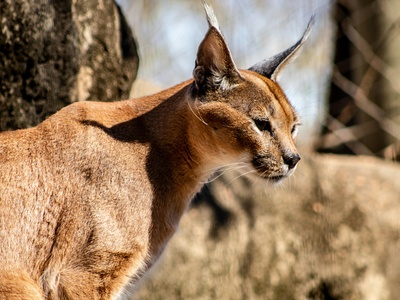
Caracal
Medium wild cat with tufted ears, reddish coat and powerful build. Native and elusive; hunts small mammals and birds by day or night. Look for distinctive ear tufts and long hind legs when glimpsed in rocky or scrubby terrain.

Sand Cat
Small, flat-faced cat with tufted ears, pale sandy coat and furry paws. Native and nocturnal; specialized desert hunter. Extremely elusive; look for round ear tufts and ground-level tracks in soft sand after dusk.

African/Arabian Wildcat
Striped, tabby-like small cat resembling a domestic cat but more robust and wary. Native and often cryptic near oases and farms. Key ID: thicker fur, stronger stripes and more wary behavior than feral cats.
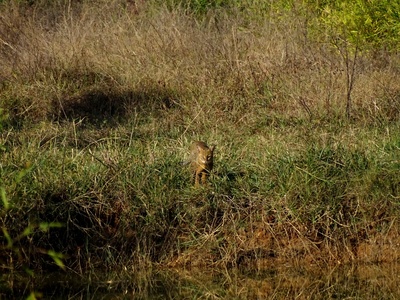
Jungle Cat
Slender, reedland-adapted cat with long legs, short tail and tufted ears. Native and associated with water-rich habitats; rarer inland. Look near mangroves, lagoons and agricultural waterways at dusk.
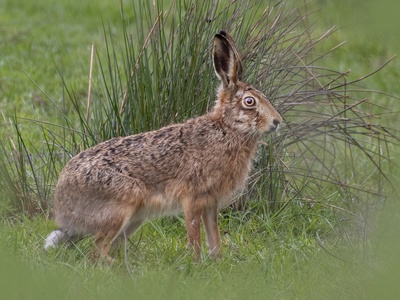
Cape Hare
Large desert hare with long ears and powerful hind legs. Native and fast; often seen at dusk bounding across open ground. Distinguished from rabbits by larger size and long ears.
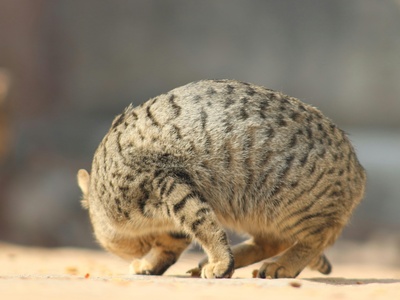
Desert Hedgehog
Small spiny mammal with broad face and nocturnal habits. Native and common in desert habitats. Identification by spines and hedgehog roll-up defense; active at night feeding on insects and small vertebrates.

Long-eared Hedgehog
Smaller hedgehog with notably long ears and pale spines. Native and nocturnal; ears distinguish it from the desert hedgehog. Found in stony deserts and foothill scrub where it feeds on insects.

Small Indian Mongoose
Small, brown carnivore introduced in some areas and now established locally. Diurnal and bold near human habitation; distinguished by slender body, short legs and inquisitive behavior. Impacts native fauna in places.

House Mouse
Tiny commensal rodent common in buildings and farms. Introduced and ubiquitous; small size, grey-brown fur and pointed snout. Look for droppings, gnaw marks and quick movements in stored-food areas.
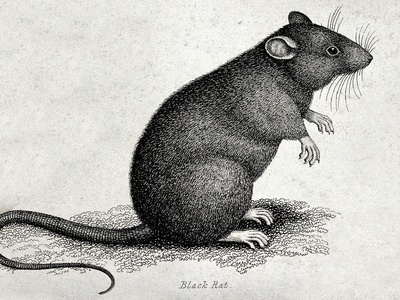
Black Rat
Slender arboreal rat with long tail and pointed snout. Introduced, thrives in ports and older structures. Often nocturnal; distinguishes from brown rat by slimmer body and larger tail relative to body length.

Brown Rat
Stocky, terrestrial rat common in cities and agricultural areas. Introduced and widespread; larger and thicker-bodied than black rat. Look for burrows, chew marks and droppings near human habitations.

Asian House Shrew
Small shrew-like insectivore with pointed snout, greyish fur and high metabolism. Introduced and common around homes and markets. Active day and night hunting insects; often mistaken for a mouse at quick glance.
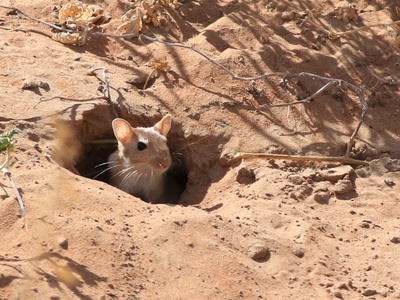
Sundevall’s Jird
Medium-sized gerbil with long hind legs and pale sandy coat. Native and fossorial; creates burrow systems in dunes. Distinguished by long tail with tuft and hopping gait when alarmed.
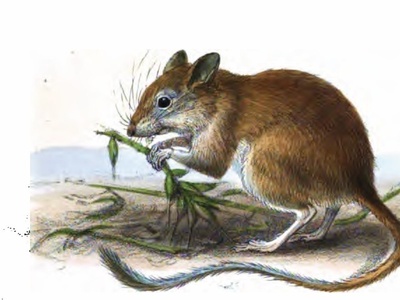
Balochistan Gerbil
Tiny desert gerbil with long hind legs and tufted tail. Native and nocturnal; quick, bounding movement and small burrows. Look for fine tracks in soft sand around shrubs after dusk.
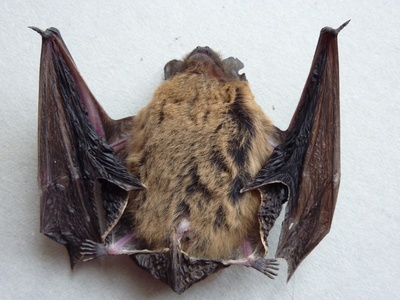
Kuhl’s Pipistrelle
Small insectivorous bat with dark fur and quick fluttering flight. Native and common around buildings and date plantations; echolocates at high frequency. Often emerges at dusk near lights.

Egyptian Fruit Bat
Medium fruit bat with fox-like face and long wings. Native and frugivorous; roosts in caves, ruins and buildings. Identified by large eyes, fruit diet and loud social calls at roosts.

Greater Mouse-tailed Bat
Long-tailed, insectivorous bat with unique long tail extending beyond tail membrane. Native and adapted to arid zones; flies with steady, strong wingbeats at dusk. Roosts in caves and abandoned buildings.
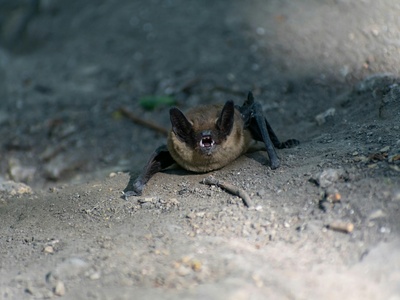
Lesser Mouse-tailed Bat
Similar to greater mouse-tailed bat but smaller; long tail and pale sandy fur. Native and nocturnal insectivore. Roosts communally in caves and rock crevices; distinctive tail beyond the uropatagium.
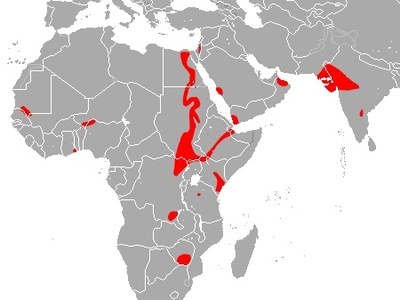
Egyptian Tomb Bat
Medium-sized free-tailed bat with pale brown fur and long wings. Native, often roosts in man-made structures and caves. Slow, straight flight at dusk; often in small colonies.

Trident Leaf-nosed Bat
Small insectivorous bat with leaf-shaped nose structure used for echolocation. Native and crevice-roosting; pale fur and fluttering flight. Often recorded in caves and rock clefts in arid areas.
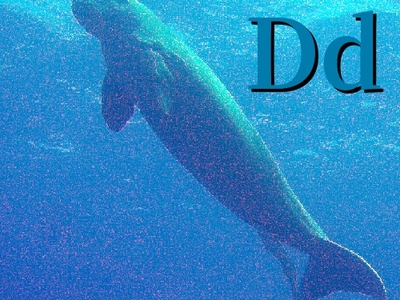
Dugong
Large marine herbivore feeding on seagrass beds. Native and vulnerable; recognizable by dolphin-like body and downturned snout. Best seen from boats near seagrass meadows; important for coastal ecosystems.

Common Bottlenose Dolphin
Robust, grey dolphin with rounded dorsal fin and pronounced beak. Native and often seen in small pods near coasts. Playful, acrobatic and frequently encountered on boat trips, easy to ID by size and forehead shape.
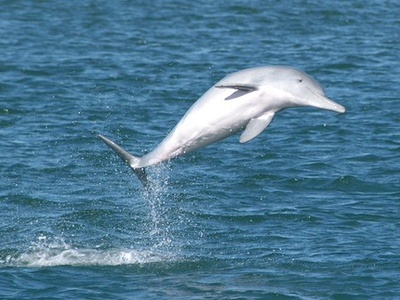
Indo-Pacific Humpback Dolphin
Stocky dolphin with rounded hump and short beak; grey with sometimes pinkish tones. Native and coastal; prefers shallow waters and estuaries. Often seen nearshore and vulnerable to coastal development.
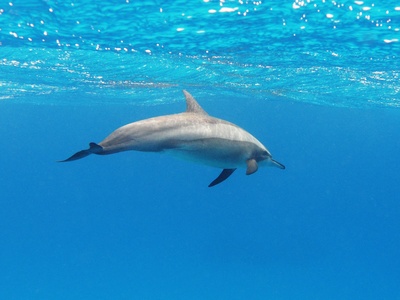
Spinner Dolphin
Slender dolphin famed for spinning leaps; long, thin beak and small dorsal fin. Native and typically offshore in groups. Seen during boat surveys; acrobatic behavior helps identification.
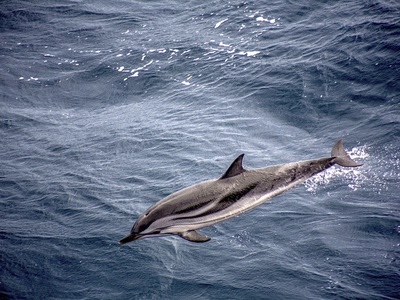
Striped Dolphin
Medium-sized pelagic dolphin with distinctive dark stripes and long beak. Native but more common offshore; occasional visitors to UAE waters. Fast-swimming and often seen in mixed-species groups.
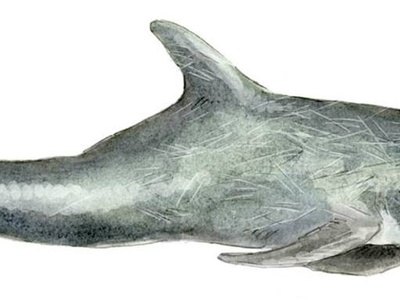
Risso’s Dolphin
Large, blunt-headed dolphin with vertical scarring on adults and tall dorsal fin. Native and generally pelagic; occasional visitors to UAE offshore waters. Distinguished by heavy scarring, robust body and social groups.


